Laser Welding of Transmitting High-Performance Engineering Thermoplastics
Abstract
1. Introduction
2. Materials and Methods
2.1. Laser Welding
2.1.1. Joint Configuration
2.1.2. Clamp System
2.2. Mechanical Testing
3. Results
3.1. Mechanical Testing
3.1.1. Base Material
3.1.2. Joints
4. Numerical Study
4.1. Finite Element Modelling
Constitutive Modeling
4.2. Uniaxial Tensile Test Simulation
5. Discussion and Conclusions
Author Contributions
Funding
Acknowledgments
Conflicts of Interest
References
- De Pelsmaeker, J.; Graulus, G.J.; Van Vlierberghe, S.; Thienpont, H.; Van Hemelrijck, D.; Dubruel, P.; Ottevaere, H. Clear to clear laser welding for joining thermoplastic polymers: A comparative study based on physicochemical characterization. J Mater Process Technol 2018, 255, 808–815. [Google Scholar] [CrossRef]
- Spancken, D.; Wacker, J.; Büter, A.; Melz, T. Multiaxial loading of thermoplastic laser welds. Weld World 2016, 60, 1261–1268. [Google Scholar] [CrossRef]
- Karlinski, J.; Ptak, M.; Dzialak, P. Improving occupant safety in heavy goods vehicles—Universal energy absorbing system. In Proceedings of the XI International Science-Technical Conference Automotive Safety, Casta, Slovakia, 18–20 April 2018; 2018; pp. 1–8. [Google Scholar] [CrossRef]
- Chen, K.; Jia, M.; Sun, H.; Xue, P. Thermoplastic Reaction Injection Pultrusion for Continuous Glass Fiber-Reinforced Polyamide-6 Composites. Materials (Basel) 2019, 12, 463. [Google Scholar] [CrossRef]
- Linul, E.; Marşavina, L. Assesment of Sandwich Beams With Rigid Polyurethane Foam Core Using Failure-Mode Maps. Proc. Romanian Acad. A 2015, 16, 522–530. [Google Scholar]
- Linul, E.; Linul, P.A.; Valean, C.; Marsavina, L.; Silaghi-Perju, D. Manufacturing and Compressive Mechanical Behavior of Reinforced Polyurethane Flexible (PUF) Foams. In IOP Conference Series: Materials Science and Engineering; IOP Publishing: Bristol, England, 2018. [Google Scholar] [CrossRef]
- Stoia, D.I.; Marşavina, L.; Linul, E. Correlations between Process Parameters and Outcome Properties of Laser-Sintered Polyamide. Polymers (Basel) 2019, 11, 1850. [Google Scholar] [CrossRef] [PubMed]
- Gürgen, S. Wear performance of UHMWPE based composites including nano-sized fumed silica. Composites Part B Eng. 2019, 173, 106967. [Google Scholar] [CrossRef]
- Bîrdeanu, A.V.; Ciuca, C. Pulsed laser welding of dissimilar thermoplastic materials. In Proceedings of the Academy Of Technical Sciences in Romania International Conference “ASTR DAYS–2011”, VIth Ed. Timișoara, Timișoara, Romania, 22–23 September 2011. [Google Scholar]
- Dawes, C.; Dawes, C. Light and lasers. Laser Weld 1992, 1–15. [Google Scholar] [CrossRef]
- Schkutow, A.; Frick, T. Improved stress-cracking resistance of laser welded amorphous thermoplastics by means of adapted wavelengths. Procedia CIRP 2018, 74, 544–547. [Google Scholar] [CrossRef]
- Mamuschkin, V.; Roesner, A.; Aden, M. Laser transmission welding of white thermoplastics with adapted wavelengths. Phys. Procedia 2013, 41, 172–179. [Google Scholar] [CrossRef]
- Amanat, N.; James, N.L.; McKenzie, D.R. Welding methods for joining thermoplastic polymers for the hermetic enclosure of medical devices. Med. Eng. Phys. 2010, 32, 690–699. [Google Scholar] [CrossRef]
- Kagan, V.A.; Bray, R.G.; Kuhn, W.P. Welding of Semi-Crystalline Thermoplastics—Part I: Optical Characterization of Nylon Based Plastics. J. Reinf. plast. Compos. 2002, 21. [Google Scholar] [CrossRef]
- Yousefpour, A.; Hojjati, M.; Immarigeon, J.-P. Fusion Bonding/Welding of Thermoplastic Composites. J. Thermoplast. Compos. Mater. 2004, 17, 303–341. [Google Scholar] [CrossRef]
- LPKF. Laser Plastic Welding, Design Guidelines Manual; Version 4.0; LPKF Laser & Electronics NA: Tualatin, OR, USA, 2019. [Google Scholar]
- Van de Ven, J.D.; Erdman, A.G. Laser Transmission Welding of Thermoplastics—Part I: Temperature and Pressure Modeling. J. Manuf. Sci. Eng. 2007, 129, 849. [Google Scholar] [CrossRef]
- Acherjee, B.; Misra, D.; Bose, D.; Venkadeshwaran, K. Prediction of weld strength and seam width for laser transmission welding of thermoplastic using response surface methodology. Opt. Laser Technol. 2009, 41, 956–967. [Google Scholar] [CrossRef]
- Hopmann, C.; Weber, M. New concepts for laser transmission welding of dissimilar thermoplastics. Prog. Rubber Plast. Recycl. Technol. 2012, 28, 157–172. [Google Scholar] [CrossRef]
- Knapp, W.; Clement, S.; Franz, C.; Oumarou, M.; Renard, J. Laser-bonding of long fiber thermoplastic composites for structural assemblies. Phys. Procedia 2010, 5, 163–171. [Google Scholar] [CrossRef]
- da Costa, A.P.; Botelho, E.C.; Costa, M.L.; Narita, N.E.; Tarpani, J.R. A review of welding technologies for thermoplastic composites in aerospace applications. J. Aerosp. Technol. Manag. 2012, 4, 255–265. [Google Scholar] [CrossRef]
- Berger, S.; Oefele, F.; Schmidt, M. Laser transmission welding of carbon fiber reinforced thermoplastic using filler material—A fundamental study. J. Laser Appl. 2015, 27, S29009. [Google Scholar] [CrossRef]
- Jaeschke, P.; Wippo, V.; Suttmann, O.; Overmeyer, L. Advanced laser welding of high-performance thermoplastic composites. J. Laser Appl. 2015, 27, S29004. [Google Scholar] [CrossRef]
- Friedrich, K. Carbon fiber reinforced thermoplastic composites for future automotive applications. AIP Conf. Proc. 2016, 1736, 1–5. [Google Scholar] [CrossRef]
- Wippo, V.; Winter, Y.; Jaeschke, P.; Suttmann, O.; Overmeyer, L. The influence of laser welding processes on the weld seam quality of thermoplastic composites with high moisture content. Phys. Procedia 2016, 83, 1064–1072. [Google Scholar] [CrossRef][Green Version]
- Kagan, V.A.; Kocheny, S.A.; Macur, J.E. Moisture effects on mechanical performance of laser-welded polyamide. J. Reinf. Plast. Compos. 2005, 24, 1213–1223. [Google Scholar] [CrossRef]
- Frick, T.; Schkutow, A. Laser transmission welding of polymers-Irradiation strategies for strongly scattering materials. Procedia CIRP 2018, 74, 538–543. [Google Scholar] [CrossRef]
- Pereira, A.B.; Fernandes, F.A.; de Morais, A.B.; Quintão, J. Mechanical Strength of Thermoplastic Polyamide Welded by Nd:YAG Laser. Polymers (Basel) 2019, 11, 1381. [Google Scholar] [CrossRef] [PubMed]
- Page, I.B. Polyamides as Engineering Thermoplastic Materials; Rapra Technology Ltd.: Shropshire, UK, 2000. [Google Scholar]
- Olabisi, O.; Adewale, K. Handbook of Thermoplastics; CRC press: Boca Raton, FL, USA, 2016. [Google Scholar]
- Goodridge, R.D.; Tuck, C.J.; Hague, R.J.M. Laser sintering of polyamides and other polymers. Prog. Mater. Sci. 2012, 57, 229–267. [Google Scholar] [CrossRef]
- Engineering, Q.; Products, P. Ertalon 6 SA (Product Data Sheet) n.d.;1425:3300. Available online: https://www.tme.eu/Document/7f85e1d9e98cd42acd899d53f22de795/Ertalon%206SA-EN.pdf (accessed on 10 February 2020).
- Fernandes, F.A.O.; Oliveira, D.F.; Pereira, A.B. Optimal parameters for laser welding of advanced high-strength steels used in the automotive industry. Procedia Manuf. 2017, 13. [Google Scholar] [CrossRef]
- Pereira, A.B.; Cabrinha, A.; Rocha, F.; Marques, P.; Fernandes, F.A.; Alves de Sousa, R.J. Dissimilar Metals Laser Welding between DP1000 Steel and Aluminum Alloy 1050. Metals (Basel) 2019, 9, 102. [Google Scholar] [CrossRef]
- Parodi, E.; Peters, G.; Govaert, L.; Parodi, E.; Peters, G.W.M.; Govaert, L.E. Structure–Properties Relations for Polyamide 6, Part 1: Influence of the Thermal History during Compression Moulding on Deformation and Failure Kinetics. Polymers (Basel) 2018, 10, 710. [Google Scholar] [CrossRef]
- Rah, K.; Paepegem, W.V.; Habraken, A.M.; Degrieck, J.; De Sousa, R.J.A.; Valente, R.A.F. Optimal low-order fully integrated solid-shell elements. Comput. Mech. 2013, 51, 309–326. [Google Scholar] [CrossRef]
- Dassault Systemes, Abaqus Theory Manual 6.10; Dassault Systèmes Simulia Corp.: Providence, RI, USA, 2010.
- Mizuguchi, Y.; Tamaki, T.; Fukuda, T.; Hatanaka, K.; Juodkazis, S.; Watanabe, W. Dendrite-joining of air-gap-separated PMMA substrates using ultrashort laser pulses. Opt. Mater. Express 2017, 7, 2141. [Google Scholar] [CrossRef]
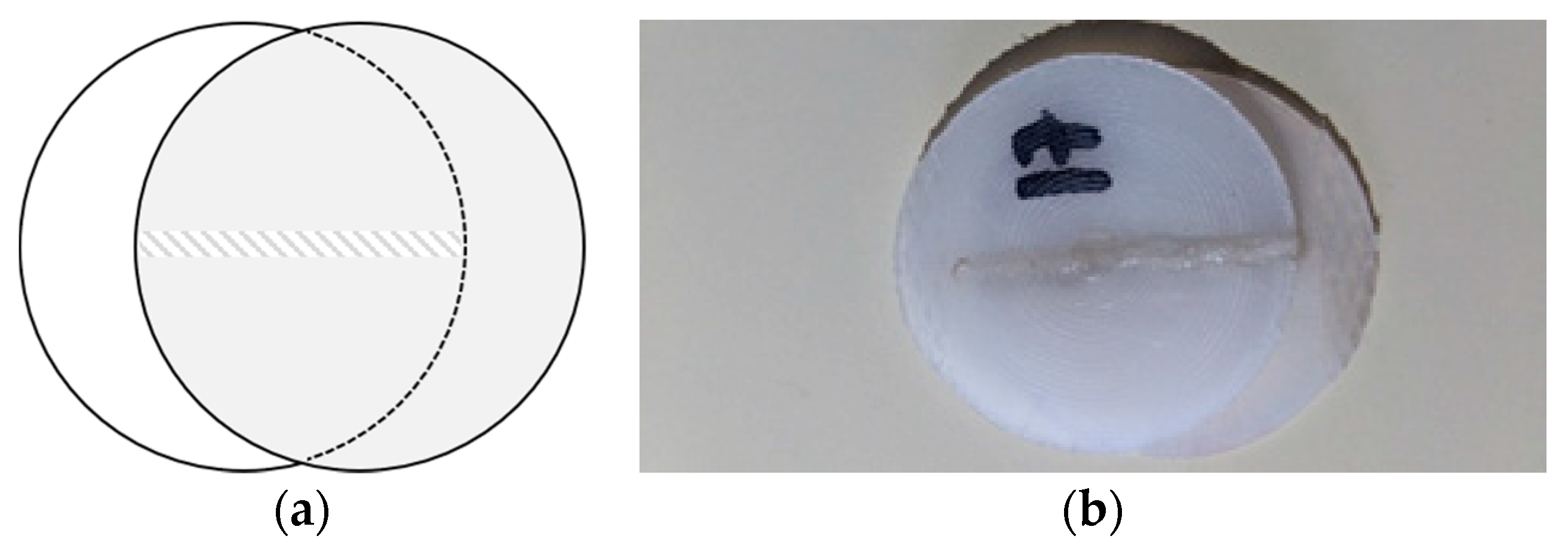
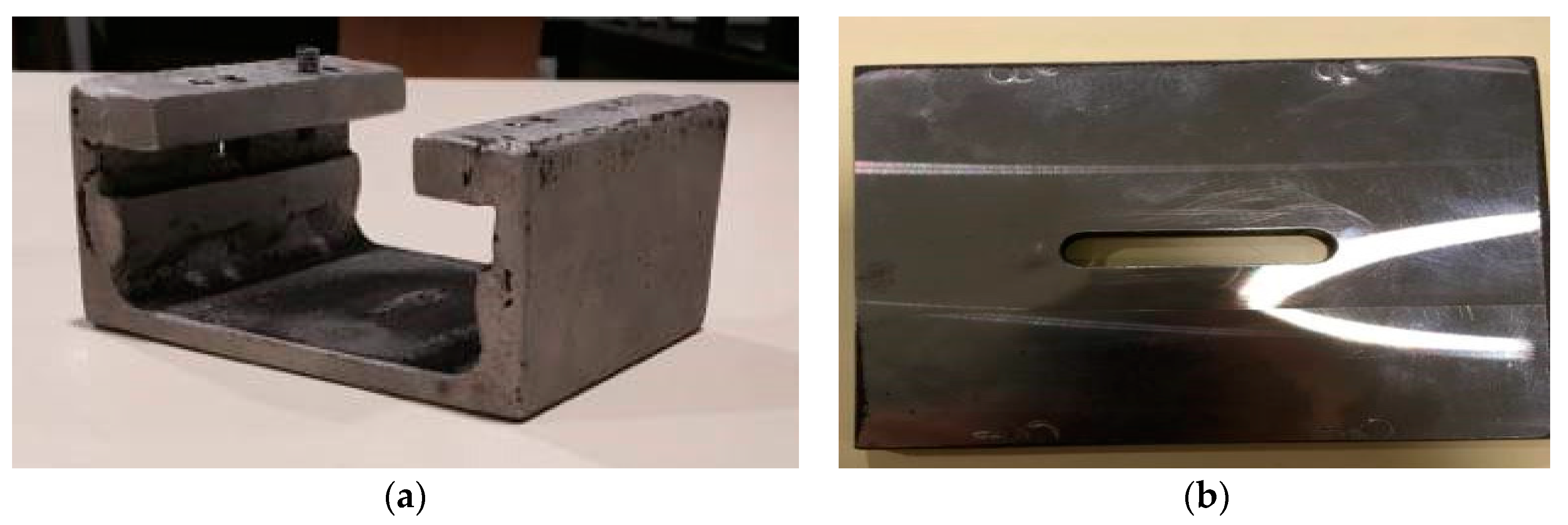
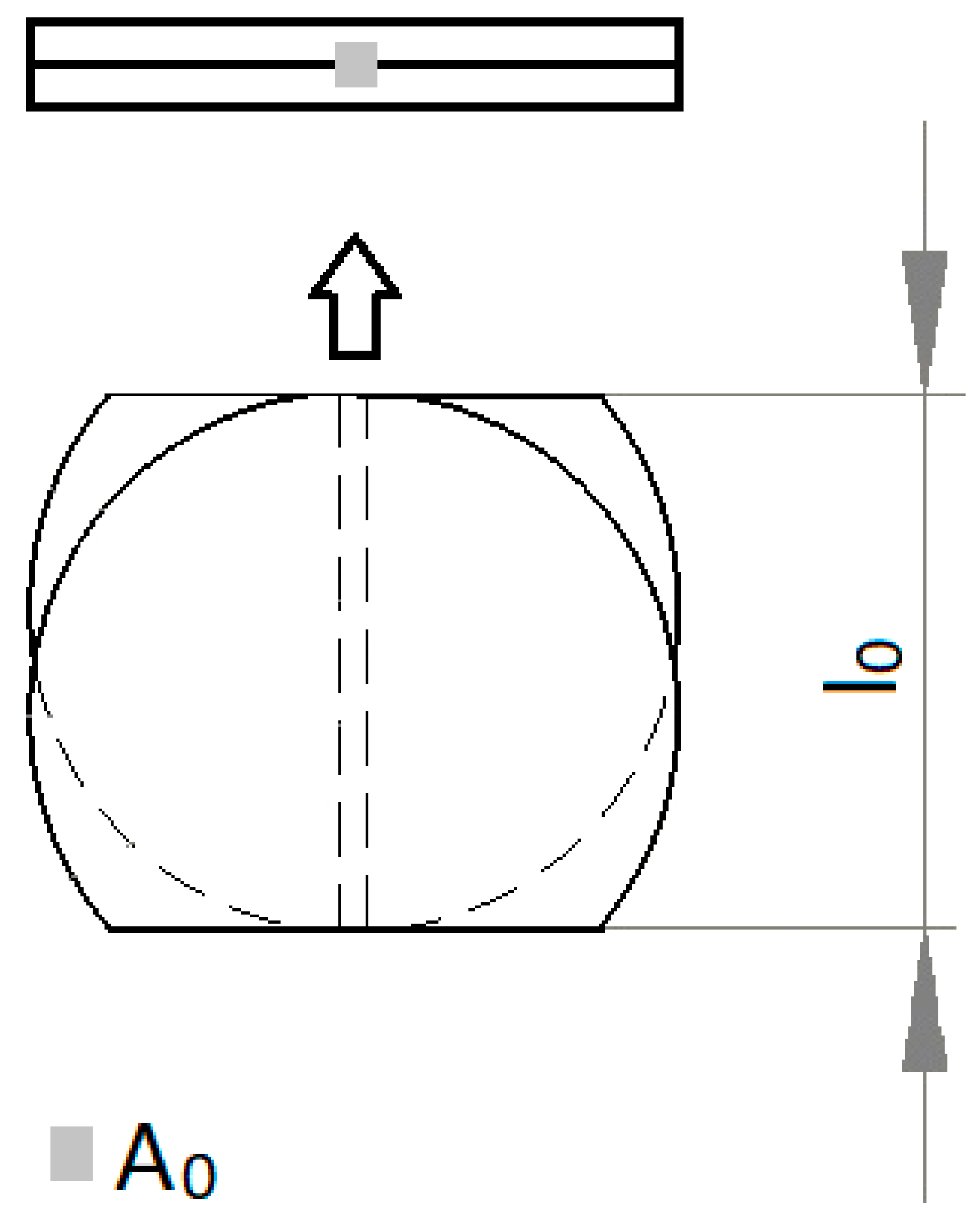

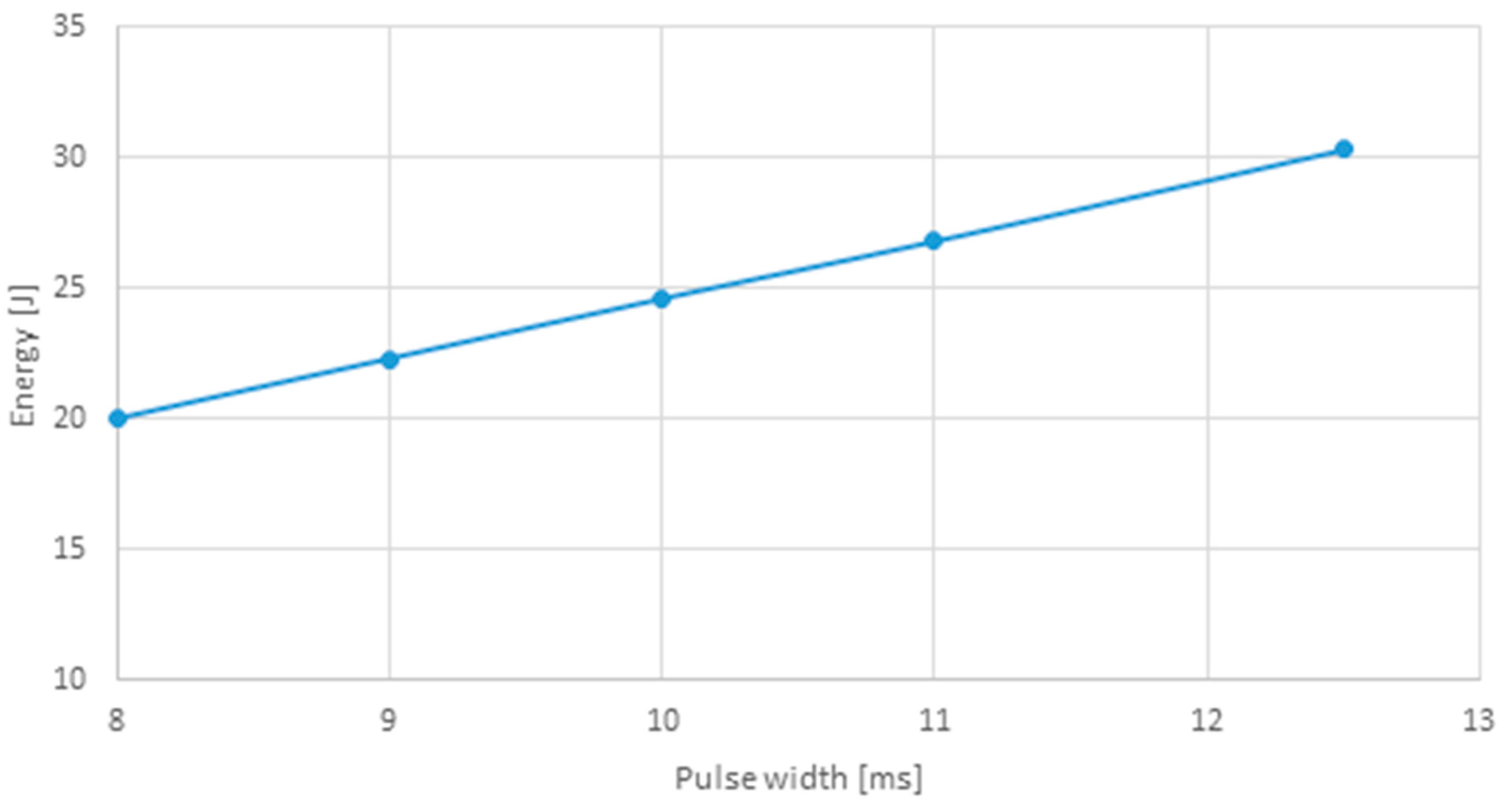
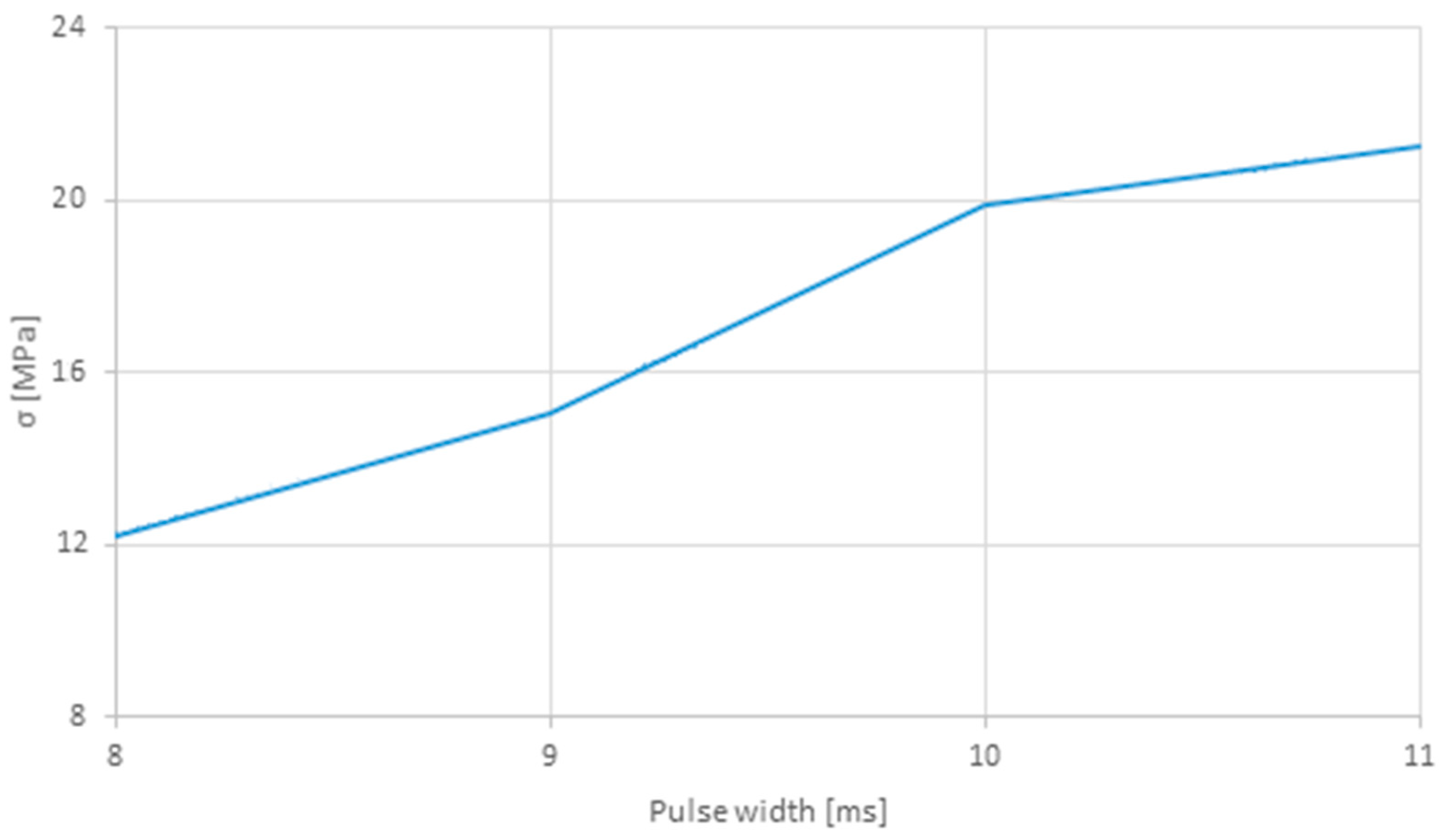
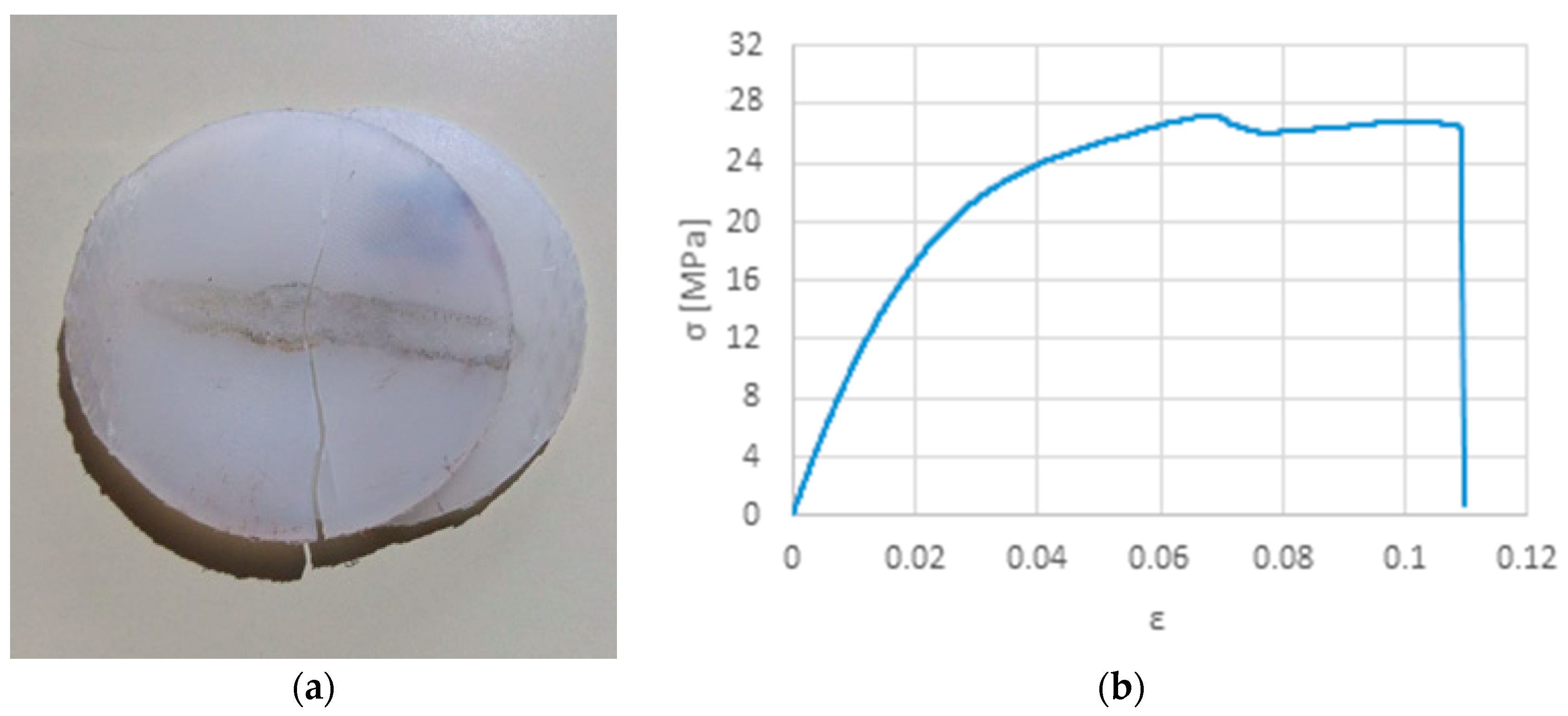

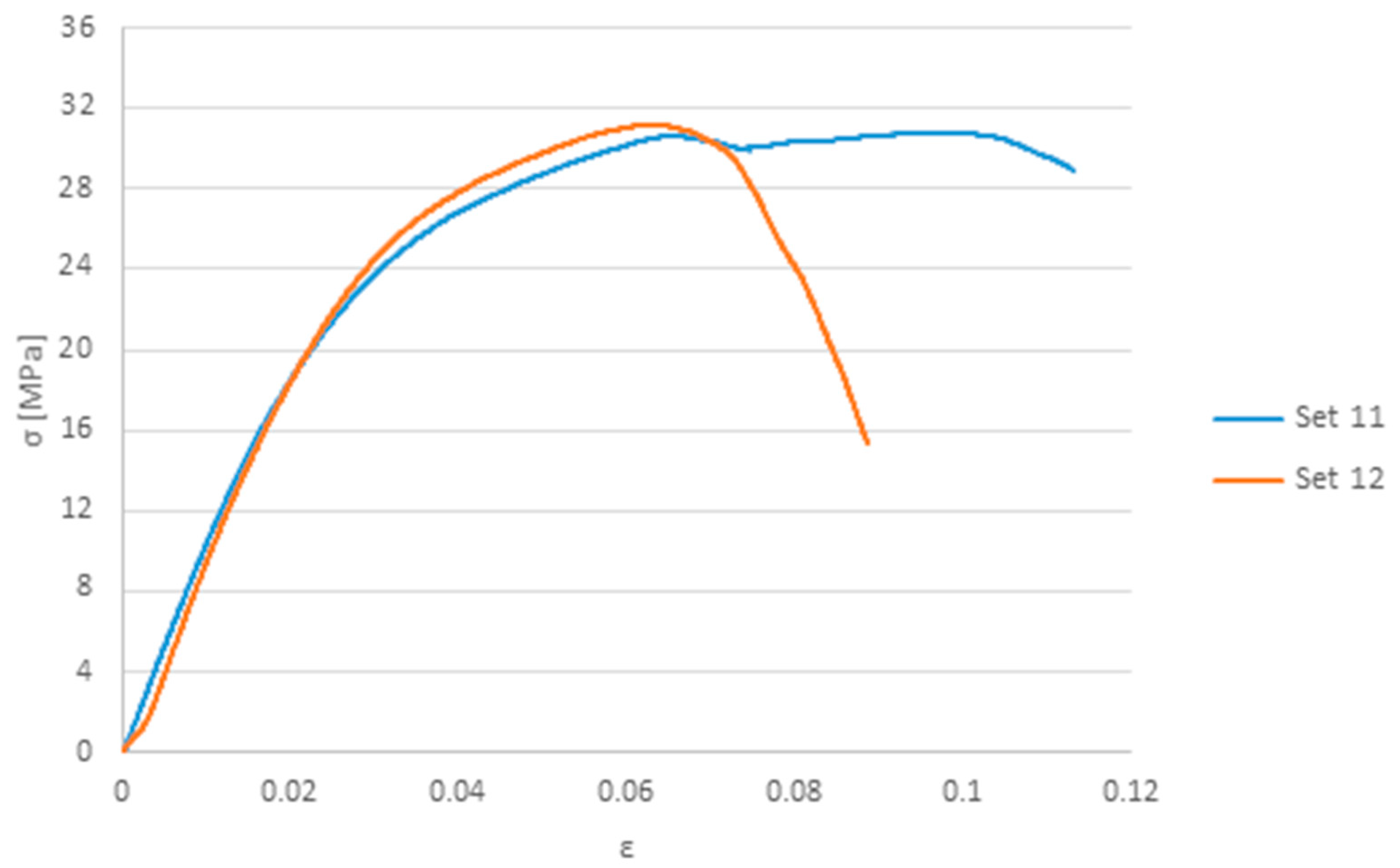
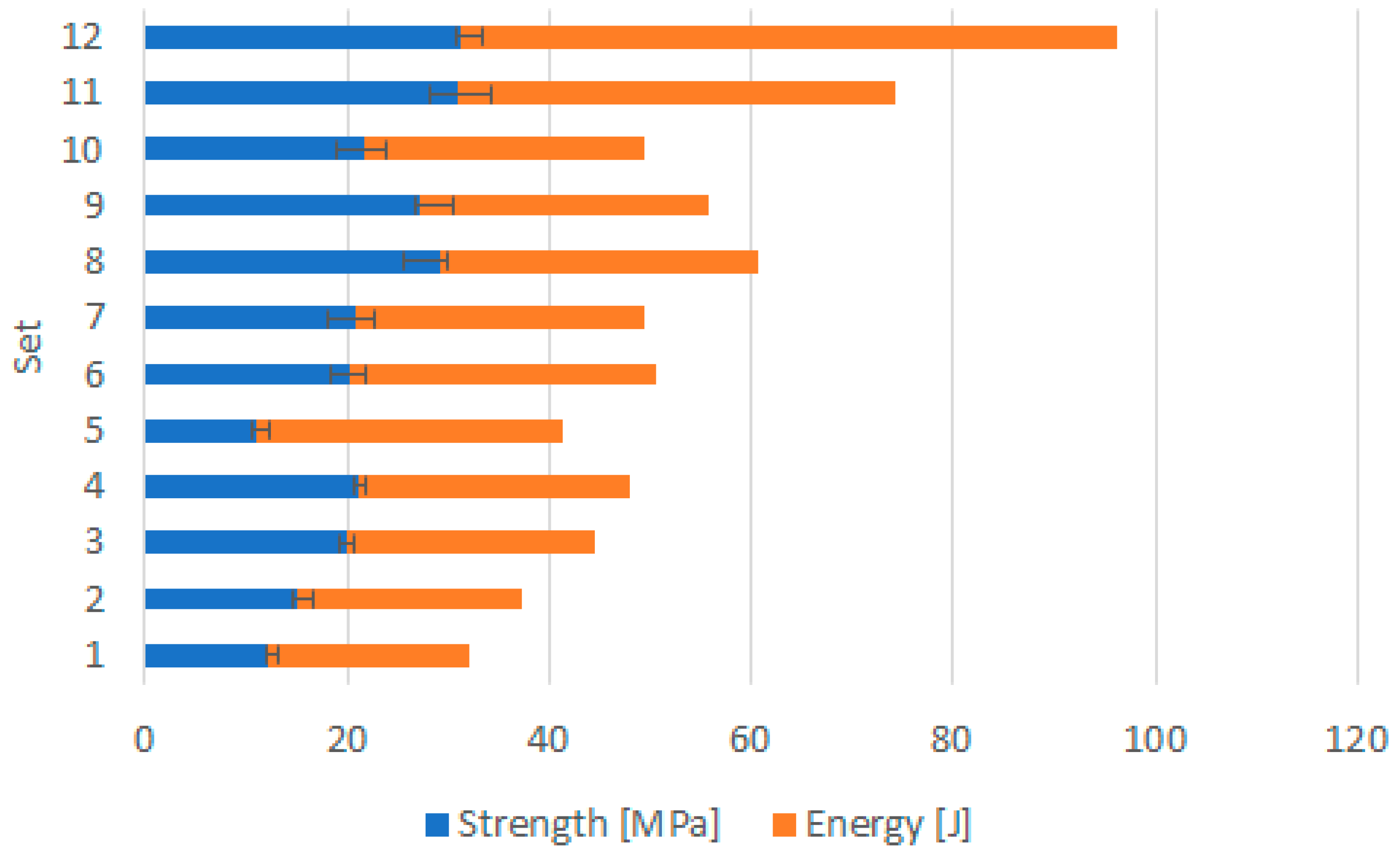
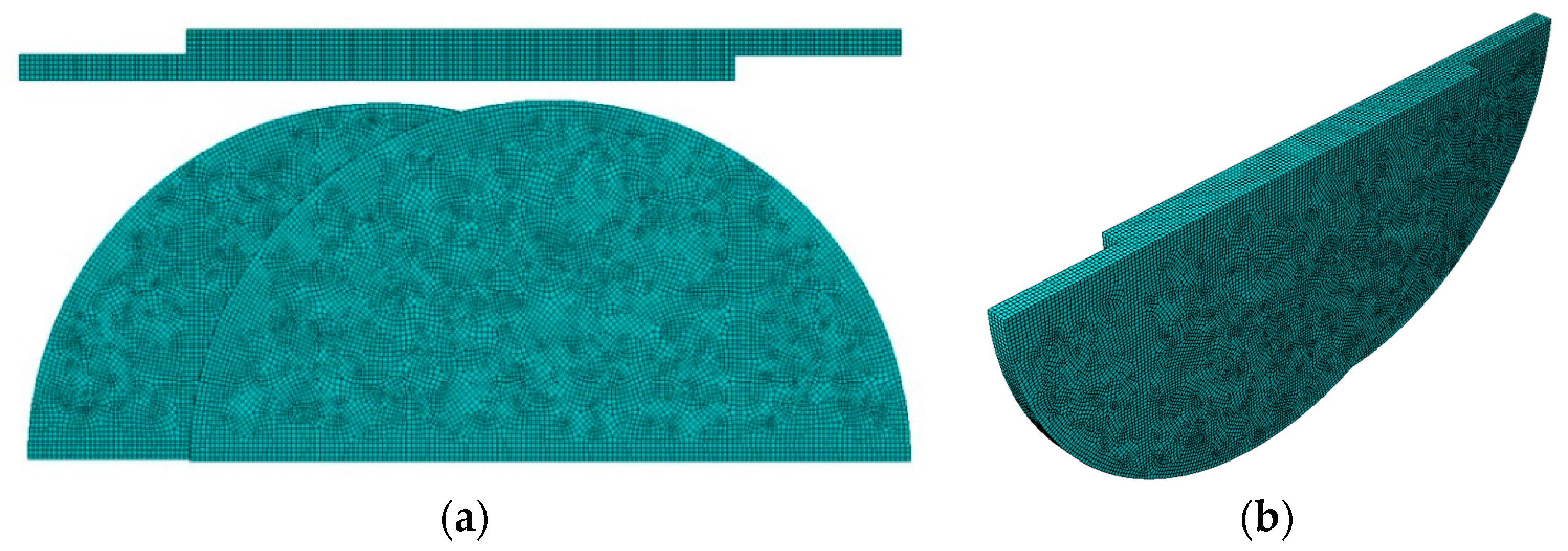
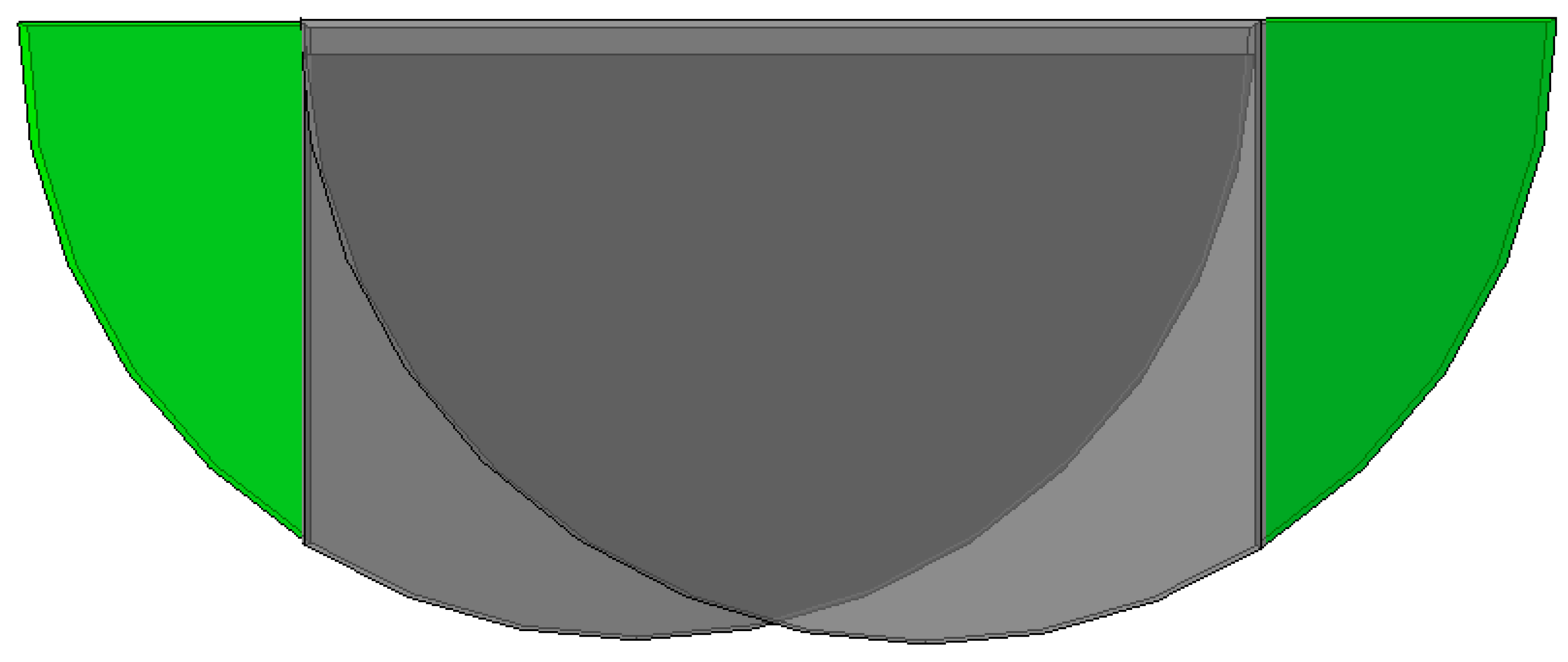
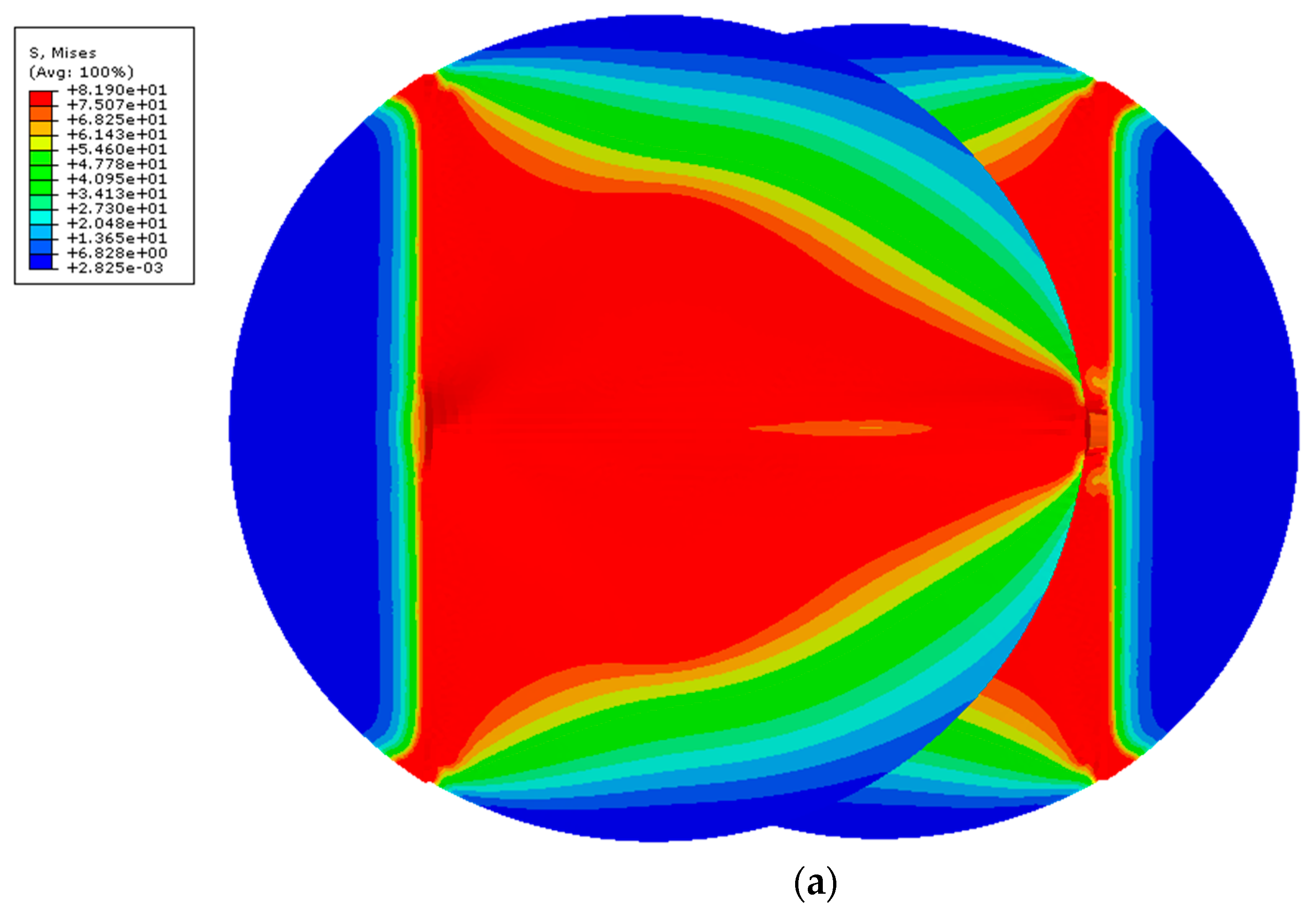




| Density [g/cm3] | Melting Temp. [°C] | Thermal Conductivity [W/(K.m)] 1 | Coef. of Linear Thermal Expansion [m/(m.K)] 2 |
|---|---|---|---|
| 1.14 | 220 | 0.28 | 90–105 × 10−6 |
| Tensile Strength [MPa] | Yield Strain [%] | Strain at Break [%] | Modulus of Elasticity [MPa] |
|---|---|---|---|
| 80 | 4 | > 50 1/100 2 | 3300 1/1425 2 |
| Refractive Index | Heat Capacity (J·K−1) | Crystallinity (%) | Peak Absorbance (nm) | Absorbance |
|---|---|---|---|---|
| 1.53 | 1.5 | 15–45 | 1390 | 0.98 |
| N | Power [%] | Pulse [ms] | Overlapping [%] | Beam Diameter [mm] | Energy [J] | Pulse Type |
|---|---|---|---|---|---|---|
| 1 | 25 | 8 | 50 | 1 | 20 |  |
| 2 | 25 | 9 | 50 | 1 | 22.3 |  |
| 3 | 25 | 10 | 50 | 1 | 24.6 |  |
| 4 | 25 | 11 | 50 | 1 | 26.8 |  |
| 5 | 25 | 12.5 | 50 | 1 | 30.3 |  |
| 6 | 25 | 12.5 | 50 | 1 | 30.3 |  |
| 7 | 25 | 12.5 | 50 | 1 | 28.5 |  |
| 8 | 25 | 12.5 | 50 | 1 | 31.4 |  |
| 9 | 25 | 12.5 | 50 | 1 | 28.7 |  |
| 10 | 25 | 12.5 | 50 | 1 | 27.9 |  |
| 11 | 30 | 15 | 50 | 1 | 43.3 |  |
| 12 | 40 | 17.5 | 50 | 1 | 64.9 |  |
| Set | Tensile Strength [MPa] | Fmax [N] | Joint (Length × Width) [mm] |
|---|---|---|---|
| 1 | 12.18 | 341.24 | 28 × 1 |
| 2 | 15.04 | 391.04 | 26 × 1 |
| 3 | 19.86 | 575.85 | 29 × 1 |
| 4 | 21.24 | 573.23 | 27 × 1 |
| 5 | 11.14 | 307.54 | 27 × 1 |
| 6 | 20.30 | 547.89 | 27 × 1 |
| 7 | 20.80 | 520.36 | 25 × 1 |
| 8 | 29.18 | 729.55 | 25 × 1 |
| 9 | 27.16 | 660.14 | 24.3 × 1 |
| 10 | 21.58 | 604.39 | 28 × 1 |
| 11 | 30.84 | 681.45 | 22.1 × 1 |
| 12 | 31.19 | 715.71 | 22.95 × 1 |
© 2020 by the authors. Licensee MDPI, Basel, Switzerland. This article is an open access article distributed under the terms and conditions of the Creative Commons Attribution (CC BY) license (http://creativecommons.org/licenses/by/4.0/).
Share and Cite
Fernandes, F.A.O.; Pereira, A.B.; Guimarães, B.; Almeida, T. Laser Welding of Transmitting High-Performance Engineering Thermoplastics. Polymers 2020, 12, 402. https://doi.org/10.3390/polym12020402
Fernandes FAO, Pereira AB, Guimarães B, Almeida T. Laser Welding of Transmitting High-Performance Engineering Thermoplastics. Polymers. 2020; 12(2):402. https://doi.org/10.3390/polym12020402
Chicago/Turabian StyleFernandes, Fábio A.O., António B. Pereira, Bernardo Guimarães, and Tiago Almeida. 2020. "Laser Welding of Transmitting High-Performance Engineering Thermoplastics" Polymers 12, no. 2: 402. https://doi.org/10.3390/polym12020402
APA StyleFernandes, F. A. O., Pereira, A. B., Guimarães, B., & Almeida, T. (2020). Laser Welding of Transmitting High-Performance Engineering Thermoplastics. Polymers, 12(2), 402. https://doi.org/10.3390/polym12020402








